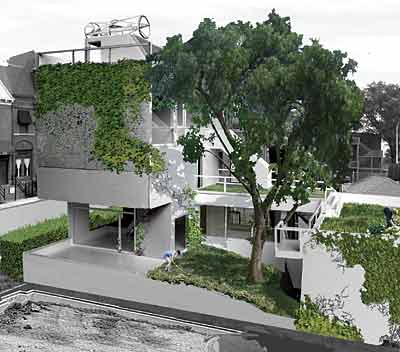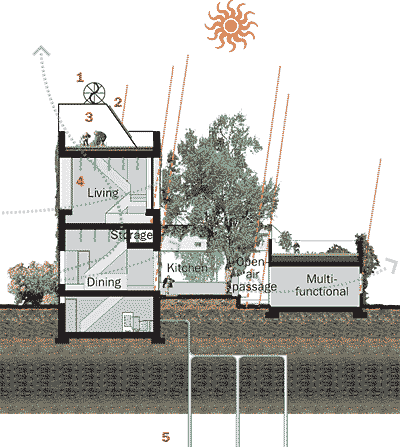The Zero Effect
With the program of the train station, Ingenhoven's firm focused on passive strategies-a popular tactic of energy reduction first, followed by an investigation of on-site generation to make up the difference. The design includes 28 so-called "light eyes," which serve multiple purposes: daylighting the underground station, relieving exhaust air, and passively removing smoke in the case of an emergency. (Ingenhoven observes that architectural systems serving more than one purpose are a hallmark of sustainable design.) Computational fluid dynamic modeling, as well as conventional wind tunnel tests, proved that a natural ventilation scheme would work since the station's tracks slope nearly 16 feet across its length and trains push air in and out. And since Germany has a relatively temperate climate, expected interior temperatures range from 46 degrees Fahrenheit in the winter to 78 degrees in the summer-not uncomfortable temperatures for passengers seasonably dressed. PVs and renewable power purchase agreements make up the station's only electricity needs for elevators and lighting.
Public, private, power
It's conventional wisdom that public institutions have been in the forefront of adopting most design and technology supporting sustainable goals. City train stations, built to last decades, must meet higher operational standards and can afford to take a longer view than the classic developer model building that requires a payback in a handful of years. At least, developers have conditioned architects to expect this.
 |
| Zero-energy house, Chicago Zoka Zola, AIA, has designed a site-sensitive single-family home for an inner-city lot that takes advantage of passive heating and cooling strategies. The house, which goes into construction this spring, will eventually support a rooftop PV system. Renderings: Courtesy Zoka Zola |
The Los Angeles Community College District (LACCD) has adopted an ambitious plan to transform its nine campuses with a net zero site energy policy. With an existing building base of 5 million square feet and plans to add 3 million more, the LACCD worried it wouldn't have money for increased energy costs for new building. Larry Eisenberg, executive director of LACCD's facilities planning and development department, says the district decided to just eliminate its $9 million annual energy bill. "A comprehensive strategy is key," Eisenberg says.
For the nine campuses to reach zero energy, the LACCD has implemented a three-part plan: improve, reduce, and generate. First, the district intends to convert each of its campuses to a central plant model, an improvement that allows systems to operate more efficiently with fewer maintenance costs. Second, the district has enlisted a third-party contractor to perform an efficiency study of its campuses and to install energy-saving technology, such as occupancy sensors, low-E glass, and better insulation. The district pays for this service out of the money the technology saves on its annual energy bill. These two preliminary strategies ensure the success of the third: the generation of power through a 9-megawatt (mw) photovoltaic installation (or 1 mw per campus).
|
What's more, the district will subcontract out the system cost and installation to a contractor/supplier (requests for proposals are due back this spring). That third party supplier could then reap federal and state tax credits to eliminate an immediate 20 percent of the PV installation cost. Further, in tax parlance, rapid depreciation of the PV system will pay for another 20 to 25 percent. Green tags-renewable energy credits-can sell on the open market to generate another 5 to 10 percent of the cost. Adding it up, Eisenberg estimates the 9 mw system will cost between 10 to 20 cents on the dollar. With these incentives, Eisenberg projects 1 mw of PVs costs between $1 million and $2 million, which translates to a one to two year payback for a campus with a $1 million annual energy bill. Eventually, the LACCD will buy the system back from the contractor. To skeptics who point to the erratic performance of PVs, which need good sunlight exposure, Eisenberg says the district is exploring a few promising options in energy storage technology, such as hydrogen-powered fuel cells.










